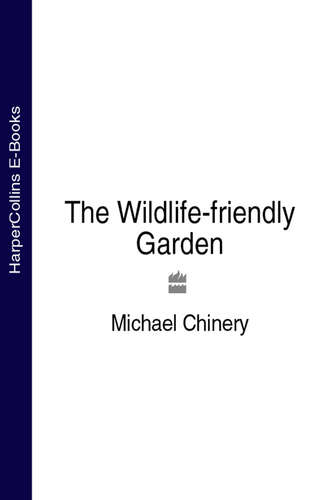
Полная версия
The Wildlife-friendly Garden
Caterpillars of the large white butterfly here surround a solitary caterpillar of the small white. Both species are major pests of cabbages and other brassicas.

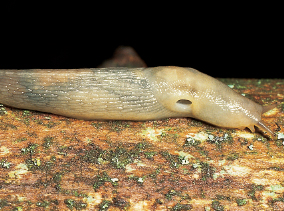
Michael Chinery
One of the worst of the gardener’s foes: the netted slug is the one we usually find in our lettuces.
Pest control
Gardening will always be a competition, with the gardener pitting his or her wits against an assortment of uninvited guests which are doing their best to damage the plants. Although you may have to get tough from time to time, it need not be all-out war. Live and let live is always a good motto for the gardener.
Avoid chemicals
One can buy chemicals, i.e. poison, to control just about every garden visitor, but they have many drawbacks. There is always a risk of killing useful or harmless creatures as well as pests. Killing useful creatures, such as ladybirds, may actually lead to an increase in the garden’s aphid population and a tendency to use ever increasing doses of insecticide. Although most modern pesticides break down rapidly in the soil, heavy applications may lead to a build-up of residues that can damage the soil and enter the food chains, where they can have far-reaching and surprising effects. Killing harmless creatures does have a knock-on effect by denying birds and other animals their natural food, so your garden will be much less interesting. The true wildlife gardener uses non-poisonous means to discourage or get rid of pests. Aphids, for example, can usually be controlled simply by squashing them with your fingers.
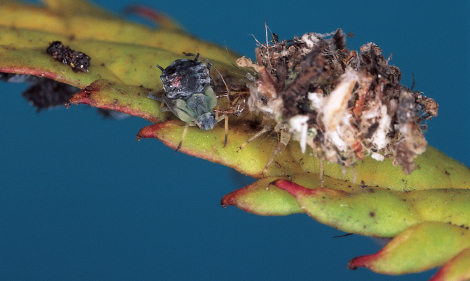
Michael Chinery
Re-cycling the empties: this lacewing larva, pictured with its jaws plunged into an aphid, camouflages itself by piling the empty skins of its victims on its back.
Cultural control
Adjusting the way you grow things, or even what you grow, can make your garden less attractive to pests. Most weeds, for example, can be eliminated by spreading a layer of chipped bark or compost over the garden. You can try growing red cabbage instead of the traditional green varieties: this may not deter the cabbage white caterpillars, but at least you can see them more easily and remove them before they do the damage!
Companion planting or inter-planting is often used to reduce damage by pests. Planting onions and carrots close together works well because the smell of the carrots deters or confuses the damaging onion-fly, and the smell of the onions discourages the carrot-fly. Roses or other flowers planted at the ends of vegetable rows attract hover-flies, which may lay eggs on aphid-infested crops. Some hover-fly larvae can demolish the aphids at a rate of one every minute!
Doing nothing and allowing nature’s web to keep the pests in check is probably the best method of all. Surely losing a few plants to beetles and caterpillars is a price well worth paying for a garden which is teeming with wildlife and with no risk of poisoning yourself or your family?
BIOLOGICAL CONTROL
Biological control, which uses natural enemies to keep pests in check, can be wonderfully effective. Introducing ladybirds and their larvae to your garden, for example, can wipe out an infestation of aphids in days. A single ladybird larva may eat 500 aphids in its three-week development. Green lacewings (see here for stockists) do a good job on summer populations of aphids, and are useful in greenhouses throughout the year.
Biological control of slugs, which are surely at the top of most gardeners’ hit-lists, can now be achieved simply by using a minute parasitic worm called Plasmarhabditis hermaphrodita. Available through good garden centres and other suppliers (see here), the worms seek out slugs and bore their way in. They multiply rapidly and the slugs literally explode, releasing another generation of worms to carry on the work. It is unlikely that the worms will move out into surrounding areas in the numbers required for slug control, so the hedgehog population will not go hungry.
Snails can be kept in check by song thrushes as long as you have sufficient anvils on which the birds can break the shells. If you have no concrete paths or rockery stones, lay a few bricks or large stones around the garden and listen for the tapping as the birds get to work.
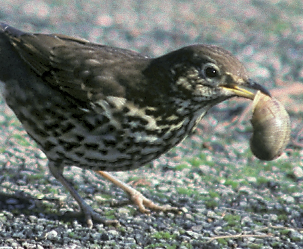
Colin Varndell
Song thrush
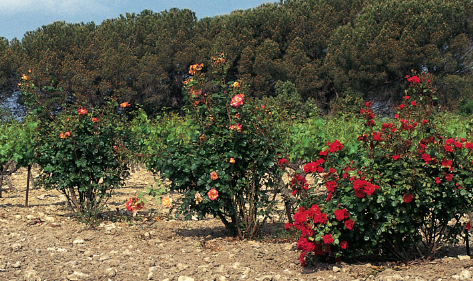
Michael Chinery
Roses are often planted in vineyards. Hover-flies, which are attracted to the flowers, lay their eggs on the surrounding vines, where their grubs attack harmful aphids and other pests.
Planning your garden
An abandoned garden soon becomes clothed with nettles, brambles and other invasive plants. Birds and some other animals may appreciate such a wilderness, but your neighbours certainly will not. Diversity is also lost. Good wildlife gardens are planned, not abandoned.
A wilderness and a wildlife garden are not the same! A wilderness, often defined as a wild and confused mass of vegetation, certainly does not exhibit the variety at the heart of a wildlife garden. It may have advantages for some animals, including the hedgehog and various birds, and there may be short-term advantages for some insects but, if left untouched, the wilderness will succumb to the processes of natural succession and will turn into woodland in 20 years or so. If you want a garden wilderness, restrict it to a particular area and be prepared to tame it occasionally. And plan the rest of your wildlife garden carefully to make the best use of the available space.
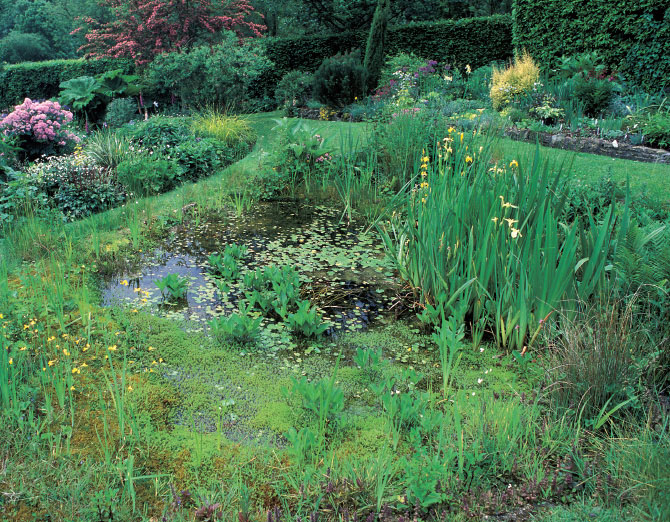
Colin Varndell
A planned garden does not have to be very formal. The position of this garden pond was actually carefully planned, but the plantlife gives it a wonderfully wild and natural appearance.
The wildlife garden cannot be ideal for everything; it has to be a compromise. However, by growing lots of different plants you can create wonderful wildlife homes and still have some room for your favourite flowers and vegetables. And you can do this even in a small garden.
Plan it on paper
Decide what features you want to include, which, in practice, usually means what you have room for, and then measure your garden carefully so that you can draw an accurate scale plan. Your aim should be to have the flower beds and other more formal or tidier parts of your garden near to the house and let them grade into the wilder-looking areas further away. This will give the whole garden a natural look and still allow you to control its structure. Remember that the pond should be in an open spot and that bird tables should be positioned where you can watch them in comfort.
When you have decided where everything is to go, you can start thinking about the plants. The soil will influence what you can grow, so have a look at neighbouring gardens and the surrounding countryside to determine which plants do well in the area. You can also use the Internet to find out which members of your local flora are worth planting in your garden (see here). Although native species are best (see here), you don’t have to ignore exotic species altogether. They lend superb colour to the garden and can provide just as much shelter for wildlife as our native species. Many also provide seasonal nectar and fruit.
Trees and hedges
Woodland margins are among the richest of all wild habitats, and an excellent way to reproduce them in your garden is to plant a hedge with a wavy margin, preferably on either the northern or the eastern boundary, or both, as this will help provide protection from cold winds without casting too much shade. It will also enable you to grow primroses, foxgloves and many other sun-loving flowers at the base. Include as many different shrubs in your hedge as you can, as this will increase its attractiveness to both birds and insects (see here). A ‘mini-spinney’, with three or four small trees, is another excellent way to mimic the woodland edge.
Ideally, the hedge should be on your northern boundary, but remember your neighbours: shelter for you might mean shade for them. Birch is a good tree in such a situation because it does not cast deep shade. It also supports over 200 insect species in Britain, and several small birds enjoy its seeds in the autumn. Alder and hawthorn are nearly as effective in this respect. Rowan, bird cherry, hazel and crab apple are other good trees for this situation, or you could try planting a cultivated apple; even a good cooker can support plenty of wildlife, from tiny insects to collared doves, and you can also enjoy the fruit yourself.

Rolando Ugolini
Among the most beautiful of all our spring flowers, the primrose graces the bottoms of many garden hedgerows. Look out for the furry bee-fly plumbing the flowers for nectar with its long, rigid tongue.
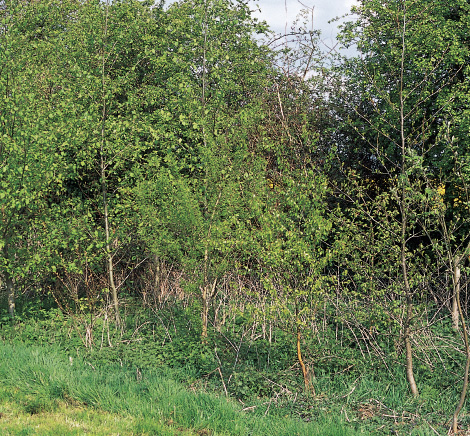
Rolando Ugolini
Just a few small trees on the edge of the garden can provide food and shelter for many creatures normally found in a woodland habitat, especially if the herbage is left uncut until autumn.
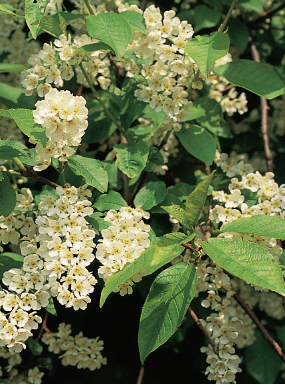
Michael Chinery
Bird cherry is an excellent tree for the wild garden. It can reach a height of 15m (45ft), but it does not cast a dense shade and it is easily kept in check by regular trimming. Laden with heavily-scented flowers in spring, the bird cherry bears shiny black fruits later in the year.
Garden paths
These can be made of brick or concrete, or paving slabs laid as stepping stones across the lawn or through the flower beds. For a more natural look, however, you can use chipped bark laid over a firmly-rolled base and retained by a kerb of rustic poles. You can disguise the edge a little by planting violets and bugle here and there and allowing them to tumble over the poles. Some interesting fungi may well spring up on the poles and on the chippings.
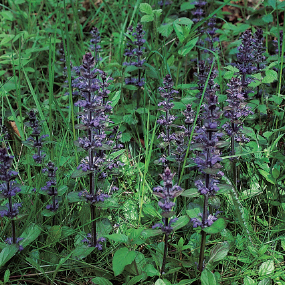
Michael Chinery
Bugle makes a colourful edging to a garden path in the spring. The wild form and the various cultivars are equally attractive to bees.
Try to make the paths curve through the garden so that you get new views at every turn and possibly a feeling that you are in a larger area. However, if you cannot do this, you can create an illusion of distance on a straight path by using large chips near the house and smaller ones further away. If your path is on a slope, put in some wooden steps here and there. Old railway sleepers are ideal, and if you drill a few holes in them you will probably attract various solitary bees (see here). You can also drill holes for them in the path edging.
Pergolas
Although pergolas tend to be associated mainly with formal gardens, they can actually be wonderful wildlife centres. Clothed with roses or honeysuckle in summer, they attract lots of insects and insect-eating birds, and some birds will readily nest in the dense climbers. You can make pergolas work for you in the winter as well by hanging an assortment of bird feeders on them. The sturdy uprights also make good supports for nest-boxes, but it is as well to move the feeders to another site before the nesting season begins: hordes of birds squabbling over a nearby bag of peanuts are not likely to make your nest-boxes desirable residences. Solitary bees and wasps will also appreciate your pergola if you drill a few small holes in the woodwork.
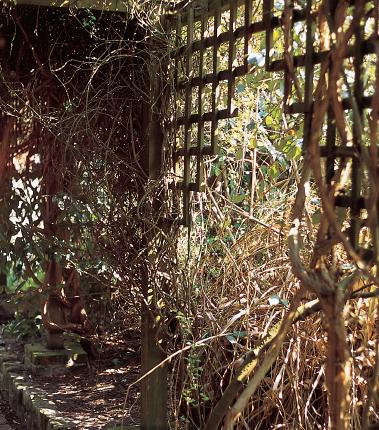
Michael Chinery
Pergolas allowed to become overgrown with an assortment of creepers can be superb for garden birds.
A wildlife meadow
In the middle of the twentieth century, flower-rich meadows could be found in many parts of Britain, but less than two per cent of the meadows that delighted us in the 1940s survive today. Unfortunately, we cannot put them back, but every little helps and a flowery lawn in your garden is a good start.
Put your mower away for a few weeks and you will certainly get some new flowers on your lawn, but unless your garden is on a chalk or limestone slope you probably will not grow much more than dandelions and daisies initially. To create a good flower-rich habitat you will have to introduce most of the flowers.
Scattering seeds into an existing lawn is not likely to achieve very much because the grasses will swamp the young seedlings, although you can increase their chances by removing the turf from small areas before sowing. Therefore a better way is to stick established plants into your lawn, but even then they are likely to be overshadowed. The best approach of all is to strip all the turf and much of the top-soil away and then re-seed the ground with a mixture of grass and flower seeds. Make sure that the grass mixture does not include rye grass, which is too vigorous for a wildflower meadow.
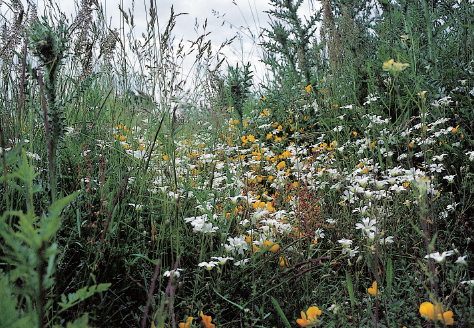
Michael Chinery
Abandon your mower and you will soon acquire a grassland jungle similar to this, where field mouse-ear and bird’s-foot trefoil are flowering below the thistles and tall flower-heads of the grasses.
Do not be tempted to sow too many species in a new lawn: four or five grasses and half a dozen flower species are plenty. Spread the grass seeds evenly over the area, but for a natural appearance the flower seeds should be sown in drifts of just two or three species. Never add any fertilizer to your meadow – this will merely encourage the grasses to grow and overshadow the other plants.
Choose your species
The chart opposite lists some of the most useful and attractive flowers for your meadow, but what you can grow successfully obviously depends on the soil. One sure way to find out what might be best for you is to have a good look at the surrounding countryside, including the roadside verges. Flowers that grow well there are likely to do well in your meadow. You can collect the seeds by shaking the ripe seed-heads into paper bags, but never dig up the wild plants. If you have access to the Internet you can call up a website that allows you to see a list of all the plants growing in your area just by inserting the first half of your postcode (see here). It also tells you whether the plants are garden-worthy and lists the suppliers of native plant seeds. It is very important always to use native seeds; foreign seeds, even if they are of the same species, may be adapted to different conditions and their genes may contaminate and damage our native flora.
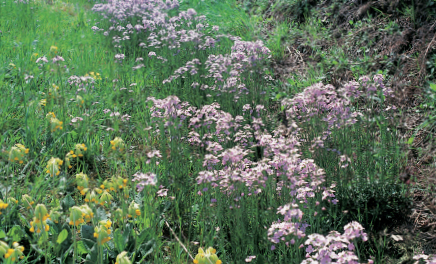
Drifts of delicate pink cuckoo flowers adorn many areas of damp grassland in the spring, and they are often accompanied by bright yellow cowslips.
Sow your seeds in the autumn, but do not expect a mass of colour in the first summer – many seeds will not even germinate until the spring, and the young plants need a full season’s growth before they are ready to flower.
Management is vital
Meadows were originally created by grazing and/or cutting, so you need to cut your flower meadow at least once a year. Use a scythe or a strimmer if possible, but if you have to use a mower make sure that the blades are not set too low.


Always leave the cut vegetation on the ground for a day or two to allow any seeds to fall, but then make sure you clear it all away because a good flower meadow depends on poor soil fertility.
If you are lucky enough to have a large meadow area, you can mow paths through it more frequently so that you can enjoy the flowers at close quarters.
An area of long grass can look untidy even if it is full of flowers, so it is a good plan to mow the edge to stop the grass from tumbling on to your path or drive. You might like to mow the area nearest to the house as well and allow it to merge gradually into the longer grass, much as a golf course fairway grades into the rough.
If you live in open countryside, you could even construct a ha-ha boundary (a sunken fence or ditch) so that your wild meadow appears to drift off into the surrounding fields.
MEADOW PLANTS
These native plants are suitable for you to plant in your wildlife meadow:
• Bladder campion • Cowslip • Cuckoo flower* • Field scabious • Greater knapweed • Ox-eye daisy • Meadow cranesbill • Ragged robin* • Self heal • YarrowPlants marked * will thrive in damp areas.
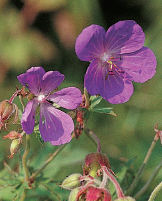
The meadow cranesbill is one of the most beautiful of our grassland species. It does best on lime-rich soils, where its bright violet-blue flowers can be seen throughout the summer.
The gardens hedge
Most houses come complete with some sort of boundary feature – a hedge or a wall if you are lucky, but more often a relatively barren wooden fence. Although walls and fences can support a limited range of plant and animal life, a mature hedgerow is a thriving community, teeming with insects and other animals. At the same time it can give you privacy and protect your garden from the wind.
You could consider enriching your garden by replacing your fence with a hedge, but only if the neighbours agree! Alternatively, you could plant a low hedge inside your boundary or instal one as the garden equivalent of a room-divider – separating your vegetables from your flower beds perhaps. Hedges are very cheap to create, although they do need more maintenance than walls and fences.
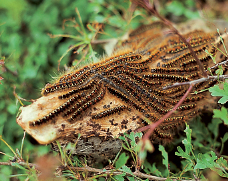
Michael Chinery
The nests of caterpillars of the small eggar moth were once common on roadside hawthorn hedges, but mechanical trimming in summer has caused the species to become rare. Garden hedges may be its salvation.
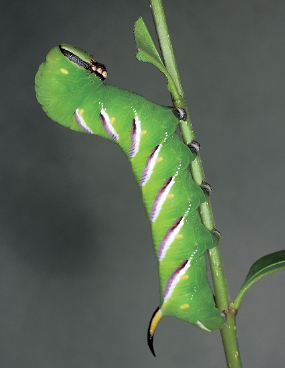
Michael Chinery
Although it is very conspicuous when viewed on a bare twig, the 10cm (4in) caterpillar of the privet hawkmoth is surprisingly hard to spot in a privet hedge.
What to plant
Although exotic species may bear plenty of tasty berries for the birds, they do not support many insects (see here), so native shrubs are best. Hawthorn is good as it grows quickly, even from cuttings, and it is eaten by more than 150 insect species in Britain alone. Blackthorn, field maple, spindle, dogwood, buckthorn, alder buckthorn and guelder rose are also good. You can encourage honeysuckle, brambles and wild roses to scramble over the hedge. In fact, the more species you can incorporate, the better.
The animal residents
A hedge is both a home and larder for numerous garden animals.


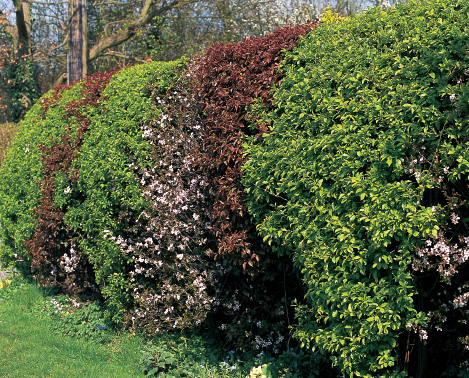
Michael Chinery







